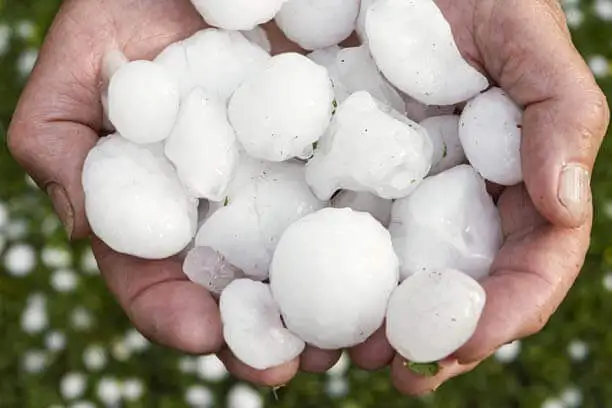Hail Safety Tips


Hailstorms often seem to appear out of nowhere, and depending on the size of the hail, can pose a risk to people and property alike. According to the National Weather Service, hail is generally no larger than 2 inches in diameter, but anything over 0.75 inches (about the size of a penny) is considered severe. Here’s how to protect your home, car and family in the event of severe hail.
Hail forms when the warm updraft of a thunderstorm pushes water droplets high enough into the clouds that they freeze. These frozen water droplets are then caused by a storm's cold downdraft and are pushed into warmer air. As the droplets begin to melt slightly, they pick up more water droplets and become larger. The little ball of ice is then picked up by the warm updraft again and is pushed up past the freezing temperatures for another time. With each pass of the cycle, the frozen water droplets become bigger and heavier. Eventually, the updrafts are no longer strong enough to push the large droplets up and around, so the balls of ice finally fall to the ground as hail. The stronger the updraft, the larger the hailstones can become. In meteorological radars, hail often shows up within the red coloration because it bounces more energy back than liquid raindrops. High winds can push hail sideways as it falls which causes damage to the sides of houses and smashes windows.
One of the best ways to prevent hail damage is by keeping your roof in good shape. Regular inspections and repairs can go a long way towards maintaining your roof. The same goes for yard upkeep — be sure to remove any weak and long branches that are close to the house.
If you know a hailstorm is in the forecast, be sure to bring your patio furniture into an enclosed space and move vehicles into a garage. No garage? Consider investing in a hail protector, especially if you live in a region where hail is common.
Bring all people and pets inside and ensure that farm animals have shelter. Once indoors, stay away from windows and skylights, and close your drapes and blinds to offer added protection from broken glass. If you’re outdoors and far from home, find the closest shelter you can and wait out the storm indoors. When hail starts while you’re driving, pull over as soon as it is safe to do so and turn your back to the windows. If you have a blanket available, use it to cover yourself and protect your face from broken glass.
Large hail is often a good indicator that a thunderstorm has the possibility to produce a tornado or high winds. The strong updrafts and downdrafts needed to produce hail can also create high winds. These winds can rip through trees causing limbs to fall and damage roofs, windows, fences, and vehicles. Wind can also tear shingles off roofs and send hail smashing through windows. The same updrafts and downdrafts needed to form hail can also form tornadoes, so be sure to stay alert and ready to shelter if needed.
Having the right coverage could protect your car, home, and other property from the high cost of hail damage. Schedule your SuperCheck today to find out if you have the right protection against hail.